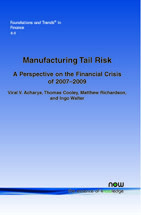Manufacturing Tail Risk: A Perspective on the Financial Crisis of 2007–2009
By Viral V. Acharya, Stern School of Business, New York University, USA, vacharya@stern.nyu.edu | Thomas Cooley, Stern School of Business, New York University, USA | Matthew Richardson, Stern School of Business, New York University, USA | Ingo Walter, Stern School of Business, New York University, USA
Abstract
We argue that the fundamental cause of the financial crisis of 2007–2009 was that large, complex financial institutions ("LCFIs") took excessive leverage in the form of manufacturing tail risks that were systemic in nature and inadequately capitalized. We employ a set of headline facts about the build-up of such risk exposures to explain how and why LCFIs adopted this new banking model during 2003–2Q 2007, relative to earlier models. We compare the crisis with other episodes in the United States, in particular, the panic of 1907, the failure of Continental Illinois and the Savings and Loan crisis. We conclude that several principal imperfections, in particular, distortions induced by regulation and government guarantees, developed in decades preceding the current one, allowing LCFIs to take on excessive systemic risk. We also examine alternative explanations for the financial crisis. We conclude that while moral hazard problems in the originate-and-distribute model of banking, excess liquidity due to global imbalances and mispricing of risk due to behavioral biases have some merit as candidates, they fail to explain the complete spectrum of evidence on the crisis.
Manufacturing Tail Risk
There is virtually universal agreement that the fundamental cause of the global economic and financial crisis of 2007-09 was the combination of a credit boom and a housing bubble, but it is much less clear why this combination of events led to such a severe financial crisis. Manufacturing Tail Risk: A Perspective on the Financial Crisis of 2007-09 argues that what made this economic shock unique and led to such a severe financial crisis was the behavior of many of the large, complex financial institutions (LCFIs) that today dominate the financial industry. These LCFIs ignored their own business model of securitization and chose not to transfer credit risk to other investors. Instead, they employed securitization to manufacture and retain tail risk that was systemic in nature and inadequately capitalized. Manufacturing Tail Risk: A Perspective on the Financial Crisis of 2007-09 provides a brief history of how the U.S. financial system evolved into its current form. It presents the manner in which banks built tail (systemic) risk exposures in large measure to get around capital requirements, in contrast to their earlier business models, and it explains how lax regulation contributed to these outcomes. It also examines alternative explanations for the financial crisis. The authors conclude that global imbalances and loose monetary policy were relevant proximate contributors to the crisis by producing an asset-price bubble in the United States that ultimately led to the financial crisis. Manufacturing Tail Risk: A Perspective on the Financial Crisis of 2007-09 concludes with a discussion of possible remedies to charge banks for manufacturing tail risks and to contain such propensity in the first place. And while the focus is on the United States, the authors review risk-taking and realized losses by LCFIs in other parts of the world.
